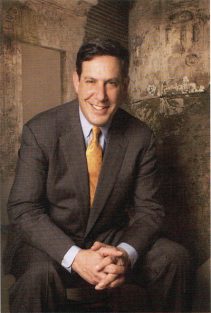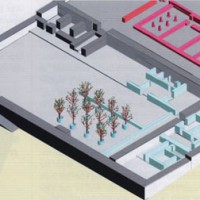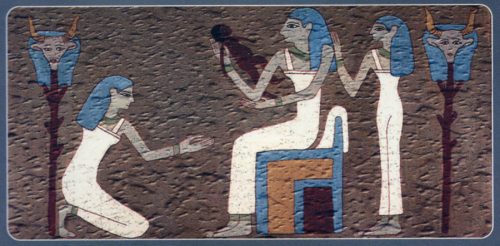Volume 48 / Number 2
2006
Special Edition: Egyptology
On The Cover: Workmen clear the entrance to the hidden subterranean tomb of Senwosret III. Photo by Josef Wegner.
Vol. 48 / No. 2
By: Jennifer Houser Wegner
David Randall-MacIver: Explorer of Abydos and Curator of The Egyptian Section
As a young man of 26, the British-born archaeologist and anthropologist David Randall-MacIver began his career working at Abydos as […]
View Article
Vol. 48 / No. 2
By: Richard M. Leventhal
The Penn Compact and Penn Museum: From the Director
President Amy Gutmann’s vision for the University of Pennsylvania — “the Penn Compact”—articulates a three-part program focused upon the main […]
View ArticleVol. 48 / No. 2
By: Josef Wegner
Beneath the Mountain-of-Anubis: Ancient Egypt's First Hidden Royal Tomb
Ancient peoples throughout the world had sophisticated understandings of their landscape. Specific elements, such as mountains, were often identified as […]
View ArticleVol. 48 / No. 2
By: James R. Mathieu
From the Editor – Summer 2006
Welcome to Expedition’s special issue on Egyptology! Here’s a detailed look at the Museum’s involvement in the archaeology of ancient […]
View ArticleVol. 48 / No. 2
By: Josef Wegner
One Pharaoh, Two Tombs
Most Egyptian pharaohs possessed only a single tomb, leaving little doubt as to where they were buried. But Senwosret III […]
View Article
Vol. 48 / No. 2
By: Dawn McCormack
Borrowed Legacy: Royal Tombs S9 and S10 at South Abydos
After the 12th Dynasty reigns of Senwsoret III (1878–1841 BCE) and Amenemhet III (1858–1812 BCE) the political and economic power […]
View ArticleVol. 48 / No. 2
By: Vanessa Smith
Food Fit for the the Soul of a Pharaoh: The Mortuary Temple's Bakeries and Breweries
Egyptian mortuary temples were more than just religious centers. They also served as the local representative of the state, combining […]
View Article
Vol. 48 / No. 2
By: Josef Wegner
Abydos And The Cult Of Osiris
Ancient Abydos (Abdju) played a lengthy and important role in the development of Egyptian civilization. Located 500 km south of […]
View Article
Vol. 48 / No. 2
By: Josef Wegner
Beautiful-Is-The-KA
Extensively excavated since 1994, the mortuary temple of Senwosret III housed a limestone cult building at its core. Its central […]
View Article
Vol. 48 / No. 2
By: Josef Wegner
Echoes of Power: The Mayor's House of Ancient Wah-Sut
Throughout history, the economic, religious, and social life of settlements has centered on special buildings such as temples, churches, post […]
View ArticleVol. 48 / No. 2
By: Nicholas S. Picardo
Egypt’s Well-to-Do: Elite Mansions in the Town of Wah-Sut
Archaeologists study settlements and households to understand how ancient people organized themselves and how social relationships played out through daily […]
View Article
Vol. 48 / No. 2
By: Stine Rossel
A Tale of the Bones: Animal Use in the Temple and Town of Wah-Sut
Many sources provide evidence of animal use in ancient Egypt. For example, the Egyptians were meticulous in depicting their natural […]
View Article
Vol. 48 / No. 2
By: Kei Yamamoto
Currelly’s Dig House
When Currelly began work at South Abydos in January 1903, Petrie’s main camp was located about 3 km away in […]
View Article
Vol. 48 / No. 2
Museum Mosaic – Summer 2006: People, Places, Projects
Treasures . . . From The Silk Road To The Santa Fe Trail Following its spectacularly successful premier in 2005, […]
View Article
Vol. 48 / No. 2
By: Josef Wegner
The Archaeology of South Abydos: Egypt's Late Middle Kingdom in Microcosm
Some 3,850 years ago a remarkable experiment in architectural and social engineering took place on the edge of the desert […]
View Article
Vol. 48 / No. 2
By: Josef Wegner
The Magical Birth Brick
In 2001 we discovered a unique object for Egyptian archaeology in the mayoral residence at South Abydos—a polychrome magical birth […]
View Article
Vol. 48 / No. 2
By: Josef Wegner
The Areryt
The same clay seal impressions that identified Building A as the mayoral residence also indicated the existence of another structure […]
View Article
Vol. 48 / No. 2
By: Kei Yamamoto
The Excitement of First Discovery: South Abydos 1899-1903
The current expedition to South Abydos follows in the footsteps of earlier explorers and archaeologists. David Randall-MacIver, Arthur C. Mace, […]
View Article
Vol. 48 / No. 2
By: John Henry Rice
Finding the Original Home of the Museum’s Brahmā: Research Notes
As early as 1924 the art historian Ananda K. Coomaraswamy recognized the importance of the Penn Museum’s Brahmā sculpture, now […]
View Article
Vol. 48 / No. 2
Holly Pittman: Curator, Near East Section: Meet the Curators
Holly Pittman, curator in the Near East Section and Deputy Director for Academic Programs at Penn Museum, discovered her passion for […]
View Article